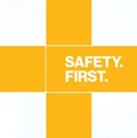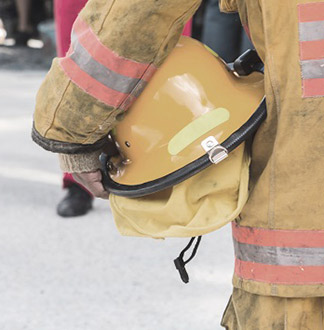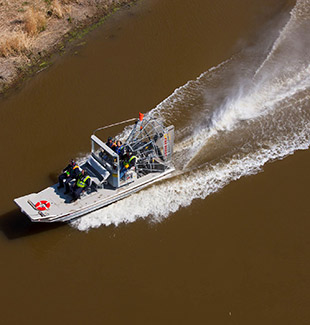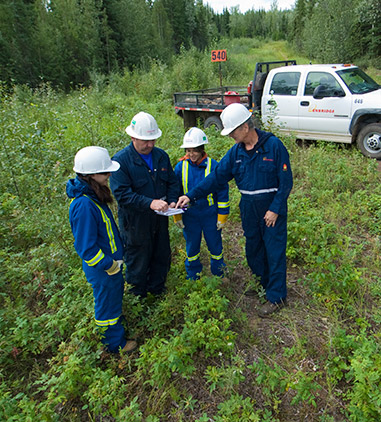Keeping you safe and informed
We communicate regularly with our neighbors—so that they’re aware of the work we’re doing, and know how to stay safe around our pipelines, gas distribution systems and facilities.
Whenever we plan a new project, we work with landowners, Aboriginal and Native American communities, our neighbors, environmental groups and regulators to plan pipeline routes that minimize environmental impact and land disturbance.
Through Enbridge’s robust Public Awareness program, we regularly provide pipeline safety information to the people who live and work along our pipeline routes, as well as public officials, emergency responders, school officials, farmers and excavators.
We also work with local first responders to build safety in the communities near our pipelines and facilities.
Safe Community
Enbridge’s Safe Community First Responder Program awards grants to local first-response emergency services, including firefighters and rescue services, emergency medical services and ambulance organizations, in North American communities near our pipelines and facilities.
Launched in 2002 in the United States, and 2009 in Canada, the Safe Community program has helped support everything from professional training and educational programs, to new firehoses, to “Jaws of Life” extrication tools, to automated external defibrillators—even major financial support of air ambulance services.
SAFE COMMUNITY IN ACTIONPutting first responders first
In addition to funding services that benefit our communities, we are committed to providing local first responders with the information, tools and training they need to protect people and property along our pipeline rights-of-way.
We make sure emergency responders:
- Know where the pipelines are located and who operates those pipelines
- Are aware of how to recognize a possible pipeline emergency and how to respond.
- Know what Enbridge does to prepare for emergencies.
Online pipeline emergency response training
Enbridge is proud to offer emergency officials in our areas of operation with free, unlimited access to online pipeline emergency response training.
This training portal is among the many initiatives the American Petroleum Institute (API) and the Association of Oil Pipe Lines (AOPL), together with supporting emergency response organizations, has created to assist first responders to learn the techniques and skills to address a hazardous liquid or natural gas pipeline incident. Using the National Association of State Fire Marshals (NASFM) “Pipeline Emergencies” Program, this best-in-class online training is provided free-of-charge to all first responders. For 911 dispatchers, the awareness course is recommended by Enbridge Emergency Management to provide information about hazards and proper response.
We’ve made it available free of charge to more than 8,000 emergency response organizations across North America. Since the creation of the program, about 3,200 emergency responders and officials, Enbridge employees and other interested parties in North America have completed the training.
Keeping in touch
We meet regularly with first responders in communities near our pipelines and facilities—including police, fire, and EMS—to share Enbridge’s emergency response procedures, and identify the roles and responsibilities of external responders who would support Enbridge in the event of an incident.
Coffee Talks in your neighborhood
As part of our community engagement, especially during pipeline construction, we regularly host open houses to keep communities informed about Enbridge in their area. It’s a great opportunity for the public to ask questions, get the information they need and learn more about Enbridge’s approach to safety and being a good neighbor.
Responding to an emergency
We hope we never have to respond to a pipeline leak. But if we do, we’re ready.
Prevention is a critical component of pipeline safety, and we focus on prevention at Enbridge before issues arise. While our ultimate goal is to prevent all spills and releases, we’re also committed as a responsible pipeline operator to providing a comprehensive incident response at any point along our pipeline network.
Enbridge maintains strong emergency preparedness and response systems that we regularly test and continuously improve alongside local first responders, emergency management officials and law enforcement.
Clink on the link below to watch video of a full-scale emergency response exercise that we staged in September 2019 in Wisconsin Rapids, WI.
Taking responsibility
We take every incident seriously, responding vigorously and cleaning up environmental impacts. We assume full responsibility, with the goal of restoring the area safely and efficiently to its pre-incident condition, or as close as possible.
Throughout the process, we work with regulators, environmental experts and our neighbors in the community to ensure the rehabilitation meets their expectations.
The Enbridge Enterprise Emergency Response team (E3RT)
In 2011, Enbridge created a cross-company team with specialized training. The E3RT regularly conducts major training exercises involving emergency response contractors and consultants, as well as emergency response agencies at the local, state/provincial, and federal levels—and is trained and ready to quickly respond to large-scale events anywhere Enbridge operates in North America. The 120 employees who make up the E3RT hold annual training sessions to brush up on their emergency response skills.
Regional emergency plans
We have tailored and detailed emergency response plans, region by region, that govern our response for all types of situations.
These plans take into consideration drinking water, flow of running water, air emissions, shoreline impacts, wildlife, animal livestock and other factors that a release could impact.
Safe digging: Know what’s below
How you can help
Your quick action could save lives, and help protect your home or your community, if an incident should occur.
- Know how to recognize a potential pipeline leak.
- Know what to do, and what not to do, in the case of a potential pipeline emergency.
- Make sure you and those around you are safe. Call 9-1-1, and then Enbridge’s 24-hour emergency hotline in your area.
Enbridge emergency contact numbers
ENGLISH | FRANÇAIS
Crude Oil and Liquids Emergency Numbers
| Canada | United States |
|---|---|
| Alberta/Northwest Territories 1 (877) 420-8800 or 1 (888) 813-6844 (Athabasca System) 1 (877) 420-8800 (Norman Wells System) Express Canada 1-888-449-7539 Saskatchewan 1 (877) 420-8800 Manitoba 1 (877) 420-8800 Ontario 1 (877) 420-8800 Quebec 1 (877) 420-8800 |
Illinois, Indiana, Kansas, Michigan, Minnesota, Missouri, New York, North Dakota, Ohio, Oklahoma, Wisconsin 1 (800) 858-5253 Express U.S. and Platte (Montana, Wyoming, Nebraska, Kansas, Missouri) 1-888-449-7539 |
Natural Gas Transmission and Midstream Emergency Numbers
| Canada | United States |
|---|---|
| Alliance Pipeline 1-800-884-8811 British Columbia and Alberta (BC Pipeline, BC Field Services, Midstream Division) 1-800-663-9931 Maritimes & Northeast Pipeline 1-888-444-6677 |
Algonquin Gas Transmission 1-800-726-8383 Big Sandy Pipeline 1-800-231-3217 Bobcat Storage Operations 1-337-585-0526 Dauphin Island Gathering Partners/DCP Midstream Gas Control 1-888-204-1781 East Tennessee Natural Gas 1-888-231-2294 Gulfstream 1-800-440-8475 Maritimes & Northeast Pipeline 1-888-576-4634 Market Hub Partners (Egan, Louisiana) 1-337-824-6100 Market Hub Partners (Moss Bluff, Texas) 1-936-336-8761 NEXUS Gas Transmission 1-855-329-1781 Sabal Trail 1-888-568-7269 Southeast Supply Header (SESH) 1-866-977-7374 Steckman Ridge 1-800-231-7794 Texas Eastern Transmission 1-800-231-7794 |
Gas Distribution Emergency Numbers
| Ontario | Quebec |
|---|---|
| Enbridge Gas Inc. 1-866-763-5427 (Southern and Eastern Ontario) 1-877-969-0999 (SW and Northern Ontario) 1-800-770-3039 (gas storage) |
Gazifère 1 (819) 771-8321 |
Renewables and Power Transmission Emergency Numbers
| Canada | United States |
|---|---|
| 24 hours, toll free 1-866-420-6630 |
24 hours, toll free 1-866-420-6630 |












